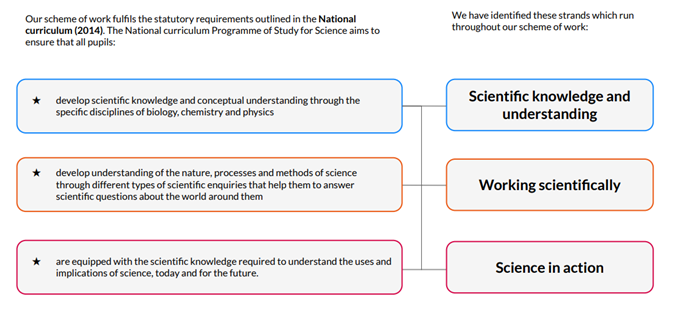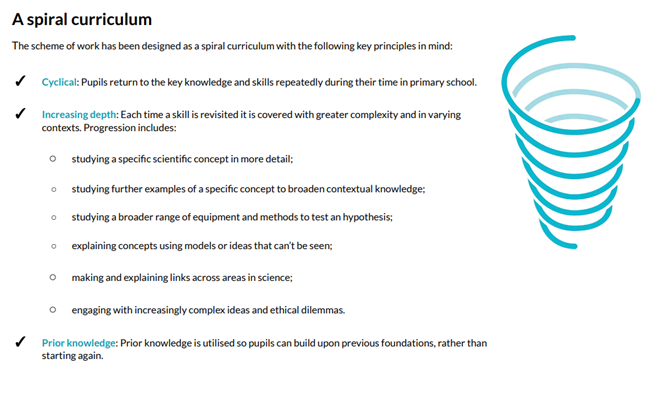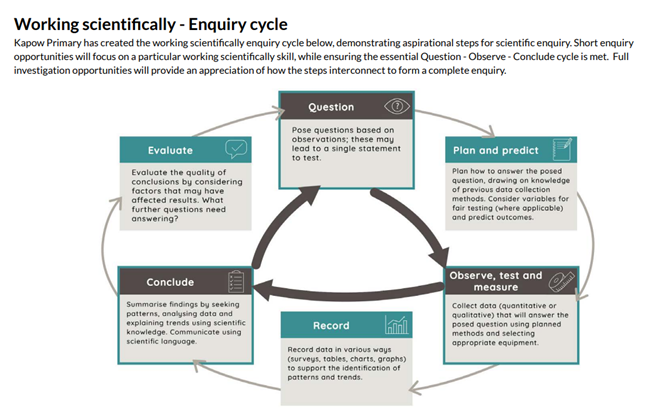At Hardwick Green, we teach Science and Design & Technology closely together, whilst retaining the distinctiveness of each subject. Use the tabs at the top of the page to read about Science and Design & Technology.
Intent:
Hardwick Green’s Science curriculum aims to develop a sense of excitement and curiosity about natural phenomena and an understanding of how the scientific community contributes to our past, present and future.
We want pupils to develop a complex knowledge of Biology, Chemistry and Physics, but also adopt a broad range of skills in working scientifically and beyond. The scheme of work is inclusive and meaningful, so all pupils may experience the joy of science and make associations between their science learning and their lives outside the classroom. Studying science allows children to appreciate how new knowledge and skills can be fundamental to solving arising global challenges.
Our curriculum aims to encourage critical thinking and empower pupils to question the ‘hows and whys’ of the world around them.
Our scheme encourages:
- A strong focus on developing knowledge alongside scientific skills across Biology, Chemistry and Physics.
- Curiosity and excitement about familiar and unknown observations.
- Challenging misconceptions and demystifying truths.
- Continuous progression by building on practical and investigative skills across all units.
- Critical thinking, with the ability to ask perceptive questions and explain and analyse evidence.
- Development of scientific literacy using wide-ranging, specialist vocabulary.
Our curriculum enables pupils to meet the end of key stage attainment targets in the national curriculum and the aims also align with those set out in the national curriculum.
Implementation:
In order to meet the aims of the National curriculum for Science and in response to the Ofsted Research
review into Science, we have identified the following key strands:
- Scientific knowledge and understanding of:
- Biology - living organisms and vital processes.
- Chemistry - matter and its properties.
- Physics - how the world we live in ‘works’.
- Working scientifically - processes and methods of science to answer questions about the world around us.
- Science in action - uses and implications of science in the past, present and for the future.

Our curriculum is a spiral curriculum, with essential knowledge and skills revisited with increasing complexity, allowing pupils to revise and build on their previous learning. A range of engaging recall activities promote frequent pupil reflection on prior learning, ensuring new learning is approached with confidence. The Science in action strand is interwoven throughout the scheme to make the concepts and skills relevant to pupils and inspiring for future application. Cross-curricular links are included throughout each unit, allowing children to make connections and apply their Science skills to other areas of learning.

Each unit is based upon one of the key science disciplines; Biology, Chemistry and Physics and to show progression throughout the school we have grouped the National curriculum content into six key areas of science:
- Plants
- Animals, including humans
- Living things and habitats
- Materials
- Energy
- Forces, Earth and space.
Pupils explore knowledge and conceptual understanding through engaging activities and an introduction to relevant specialist vocabulary. As suggested in Ofsted’s Science research review (April 2021), the ‘working scientifically’ skills are integrated with conceptual understanding rather than taught discretely. This provides frequent, but relevant, opportunities for developing scientific enquiry skills. The scheme utilises practical activities that aid in the progression of individual skills and also provides opportunities for full investigations.

Lessons incorporate various teaching strategies from independent tasks to paired and collaborative work, including practical, creative, computer-based and collaborative tasks. Knowledge organisers for each unit help to identify prior and future curriculum links to make the scheme as meaningful as possible and reinforce key technical terms.
Strong subject knowledge is vital for staff to deliver a highly effective and robust Science curriculum. Each unit of lessons from the scheme includes multiple teacher videos and resources to develop subject knowledge, target fundamental misconceptions effectively and support ongoing CPD.
Impact:
The impact of our curriculum is constantly monitored through both formative and summative assessment opportunities. Each lesson plan includes guidance to support teachers in assessing pupils against the learning objectives and any relevant scientific enquiry skills. Opportunities for children to communicate using scientific vocabulary also form part of the assessment process in each unit.
After studying the curriculum, pupils should leave school equipped with the requisite skills and knowledge to succeed in key stage 3 Science. They will have the necessary tools to confidently and meaningfully question and explore the world around them as well as critically and analytically experiencing and observing phenomena. Pupils will understand the significance and impact of Science on society.
The expected impact of studying our curriculum is that children will:
- Develop a body of foundational knowledge for the Biology topics in the National curriculum: Plants; Animals, Including Humans; Living Things and Their Habitats; Evolution and Inheritance.
- Develop a body of foundational knowledge for the Chemistry topics in the National curriculum: Everyday Materials; Uses of Everyday Materials; Properties and Changes of Materials; States of Matter; Rocks.
- Develop a body of foundational knowledge for the Physics topics in the National curriculum: Seasonal Changes; Forces and Magnets; Sound; Light; Electricity; Earth and Space.
- Be able to evaluate and identify the methods that ‘real world’ scientists use to develop and answer scientific questions.
- Identify and use equipment effectively to accurately gather, measure and record data.
- Be able to display and convey data in a variety of ways, including graphs.
- Analyse data in order to identify, classify, group, and find patterns.
- Use evidence to formulate explanations and conclusions.
- Demonstrate scientific literacy through presenting concepts and communicating ideas using scientific vocabulary.
- Understand the importance of resilience and a growth mindset, particularly in reference to scientific enquiry.
- Meet the end of key stage expectations outlined in the National curriculum for Science.
Science
Intent:
Our Design and technology curriculum aims to inspire pupils to be innovative and creative thinkers who have an appreciation for the product design cycle through ideation, creation, and evaluation. We use the Kapow primary scheme of work as a basis for our curriculum, but we have integrated it to our own bespoke STEM (Science, Technology, Engineering & Maths) curriculum. To this end, we teach design & technology hand-in-hand with science, making purposeful links to reinforce the acquisition of knowledge whilst also retaining the distinctiveness of the subject in its own right.
We want pupils to develop the confidence to take risks, through drafting design concepts, modelling, and testing and to be reflective learners who evaluate their work and the work of others. Through our scheme of work, we aim to build an awareness of the impact of design and technology on our lives and encourage pupils to become resourceful, enterprising citizens who will have the skills to contribute to future design advancements.
Our Design and technology curriculum enables pupils to meet the Early Learning Goals and the end of key stage attainment targets in the National curriculum. The aims of our curriculum also align with those in the National curriculum.
Implementation:
Our Design and technology curriculum outlines the three main stages of the design process: design, make and evaluate. Each stage of the design process is underpinned by technical knowledge which encompasses the contextual, historical, and technical understanding required for each strand. Cooking and nutrition has a separate section, with a focus on specific principles, skills and techniques in food, including where food comes from, diet and seasonality.
The National curriculum organises the Design and technology attainment targets under five subheadings or strands:
• Design
• Make
• Evaluate
• Technical knowledge
• Cooking and nutrition
Our Design and technology curriculum has a clear progression of skills and knowledge within these five strands across each year group. Our Progression of skills shows the skills and knowledge that are taught within each year group and how these skills develop to ensure that attainment targets are securely met by the end of each key stage.
Through our Design and technology scheme, pupils respond to design briefs and scenarios that require consideration of the needs of others, developing their skills in five key areas:
• Mechanisms
• Structures
• Textiles
• Food and
• Electrical systems (KS2)
Each of our key areas follows the design process (design, make and evaluate) and has a particular theme and focus from the technical knowledge or cooking and nutrition section of the curriculum. Our curriculum is a spiral curriculum, with key areas revisited again and again with increasing complexity, allowing pupils to revisit and build on their previous learning.
Lessons incorporate a range of teaching strategies from independent tasks, paired and group work including practical hands-on, computer-based and inventive tasks.
Differentiated guidance is available for every lesson to ensure that lessons can be accessed by all pupils and opportunities to stretch pupils’ learning are available when required. Knowledge organisers for each unit support pupils in building a foundation of knowledge by encouraging recall of key facts and vocabulary.
Strong subject knowledge is vital for staff to be able to deliver a highly effective and robust Design and technology curriculum. To ensure this, each unit of lessons in our curriculum includes multiple teacher videos to develop subject knowledge and support ongoing CPD.
Impact:
The impact of our curriculum is be constantly monitored through both formative and summative assessment opportunities.
Each lesson plan includes guidance to support teachers in assessing pupils against the learning objectives. Furthermore, each unit has a unit quiz which is used at the end of the unit to assess technical knowledge. Teachers can also assess children’s through evaluation of final products against design criteria.
After the implementation of our Design and technology curriculum, pupils should leave school equipped with a range of skills to enable them to succeed in their secondary education and be innovative and resourceful members of society.
The expected impact our Design and technology curriculum is that children will:
• Understand the functional and aesthetic properties of a range of materials and resources.
• Understand how to use and combine tools to carry out different processes for shaping, decorating, and manufacturing products.
• Build and apply a repertoire of skills, knowledge and understanding to produce high quality, innovative outcomes, including models, prototypes, CAD, and products to fulfil the needs of users, clients, and scenarios.
• Understand and apply the principles of healthy eating, diets, and recipes, including key processes, food groups and cooking equipment.
• Have an appreciation for key individuals, inventions, and events in history and of today that impact our world.
• Recognise where our decisions can impact the wider world in terms of community, social and environmental issues.
• Self-evaluate and reflect on learning at different stages and identify areas to improve.
• Meet the end of key stage expectations outlined in the National curriculum for Design and technology.
.jpg)
.jpg)
.jpg)
.jpg)
.jpg)
.jpg)
.jpg)
.jpg)
.jpg)